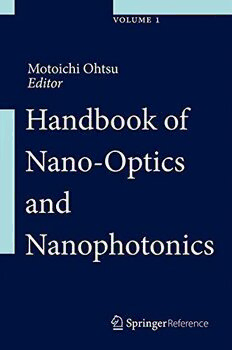
Handbook of nano-optics and nanophotonics PDF
Preview Handbook of nano-optics and nanophotonics
Motoichi Ohtsu Editor Handbook of Nano-Optics and Nanophotonics 1 3 Reference HandbookofNano-OpticsandNanophotonics Motoichi Ohtsu Editor Handbook of Nano-Optics and Nanophotonics With732Figuresand24Tables Editor MotoichiOhtsu GraduateSchoolofEngineering TheUniversityofTokyo Tokyo,Japan ISBN978-3-642-31065-2 ISBN978-3-642-31066-9(eBook) ISBN978-3-642-31067-6(printandelectronicbundle) DOI10.1007/978-3-642-31066-9 SpringerHeidelbergNewYorkDordrechtLondon LibraryofCongressControlNumber:2013936745 ©Springer-VerlagBerlinHeidelberg2013 Thisworkissubjecttocopyright.AllrightsarereservedbythePublisher,whetherthewholeorpartof thematerialisconcerned,specificallytherightsoftranslation,reprinting,reuseofillustrations,recitation, broadcasting,reproductiononmicrofilmsorinanyotherphysicalway,andtransmissionorinformation storageandretrieval,electronicadaptation,computersoftware,orbysimilarordissimilarmethodology nowknownorhereafterdeveloped.Exemptedfromthislegalreservationarebriefexcerptsinconnection with reviews or scholarly analysis or material supplied specifically for the purpose of being entered and executed on a computer system, for exclusive use by the purchaser of the work. Duplication of this publication or parts thereof is permitted only under the provisions of the Copyright Law of the Publisher’slocation,initscurrentversion,andpermissionforusemustalwaysbeobtainedfromSpringer. PermissionsforusemaybeobtainedthroughRightsLinkattheCopyrightClearanceCenter.Violations areliabletoprosecutionundertherespectiveCopyrightLaw. Theuseofgeneraldescriptivenames,registerednames,trademarks,servicemarks,etc.inthispublication doesnotimply,evenintheabsenceofaspecificstatement,thatsuchnamesareexemptfromtherelevant protectivelawsandregulationsandthereforefreeforgeneraluse. While the advice and information in this book are believed to be true and accurate at the date of publication,neithertheauthorsnortheeditorsnorthepublishercanacceptanylegalresponsibilityfor anyerrorsoromissionsthatmaybemade.Thepublishermakesnowarranty,expressorimplied,with respecttothematerialcontainedherein. Printedonacid-freepaper SpringerispartofSpringerScience+BusinessMedia(www.springer.com) Preface Recent advances in photonic systems demand drastic increases in the degree of integrationofphotonicdevicesforlarge-capacity,ultrahigh-speedsignaltransmis- sionandinformationprocessing.Devicesize hastobescaleddowntonanometric dimensions to meet this requirement, which will become even more strict in the future. Moreover, the equipment used for fabricating photonic devices must drastically decrease the size of the fabricated patterns in order to achieve ultra- large-scaleintegratedcircuits. However,these requirementscannotbe meteven if thephysicaldimensionsofmaterialstructuresaredecreasedbyadvancedmethods based on nanotechnology.It is also essential to decrease the spatial extent of the electromagnetic field used as a carrier for signal transmission, processing, and fabrication.Reducingtheelectromagneticfieldtodimensionsbeyondthediffraction limitofpropagatingfieldispossiblebyusingopticalnearfields.Nano-opticsdeals withthelightgeneratedinoronnanometer-sizedparticles.Theconceptshavebeen applied to open up an innovative field of technology “nanophotonics” allowing the development of novel photonic devices, fabrication techniques, and systems. Nanophotonics,proposedbytheauthorin1993,isanovelopticaltechnologythat exploitstheuniquepropertiesoftheopticalnear-fieldordressedphoton. The interest in nanophotonics is due not only to its ability to meet the above requirementsbutalsotoitsqualitativeinnovationsinphotonicdevices,fabrication techniques,energyconversion,andinformationprocessingsystemsbyutilizingthe novel functions and phenomena made possible by optical near-field interactions, which are otherwise impossible with conventional propagating light. Based on interdisciplinary studies involving condensed-matter physics, optical science, and quantumfieldtheory,nano-materialsandopticalenergytransferinthenanometric regime have been extensively studied in the last two decades. Through these studies,noveldressedphotontheorieshavebeendeveloped,andavarietyofnovel phenomenahave been found.The results of this basic research have been applied to develop nanometer-sized photonic devices, nanometer-resolution fabrication techniques, highly efficient energy conversion, and novel information processing, resultinginqualitativeinnovations.Furtheradvancementintheseareasisexpected to createnovelopticalsciences in the nanometricdomain,whichwill spur further progressinnanophotonicsthatwillhelptosupportthesustainabledevelopmentof people’slivesallovertheworld. v vi Preface This unique text “Handbook of Nano-optics and Nanophotonics” has been published to review the results of advanced studies in the field of nanophotonics andcoversthemostrecenttopicsoftheoreticalandexperimentalinterestinrelevant fields. It is composed of six parts, and the chapters in these parts are written by leadingscientistsintherelevantfield.Thus,thishandbookwillprovidehigh-quality scientific and technical information to scientists, engineers, and students who are orwillbeengagedinnanophotonicsresearch.Eachchapteroriginallyappearedin the monograph series “Progress in Nano-Electro-Optics I–VII” and “Progress in NanophotonicsI”(editedbyM.Ohtsu,publishedintheSpringerSeriesinOptical Science). The content of each original article has been revised, expanded, and updatedforinclusioninthishandbook. IamgratefultoDr.C.AscheronofSpringer-Verlagforhisguidanceandsugges- tionsthroughoutthepreparationofthishandbook.Thishandbookispublishedwith thesupportofProf.T.YatsuioftheUniversityofTokyo,anassociateeditor.Ihope thatthishandbookwillbe a valuableresourceforreadersandfuturespecialists in nanophotonics. April2013 MotoichiOhtsu Tokyo,Japan About the Editor Motoichi Ohtsu Graduate School of Engineering, The University of Tokyo, Tokyo,Japan MotoichiOhtsureceivedhisDr. Eng.degreeinElectronicsEngineeringfromthe TokyoInstitute ofTechnology,Tokyo,in 1978.He wasfirstappointedasresearch associate,thenasassociateprofessor,andfinallyasprofessorattheTokyoInstitute of Technology. From 1986 to 1987, while on leave from the Tokyo Institute of Technology, he joined the Crawford Hill Laboratory, AT&T Bell Laboratories, Holmdel, New Jersey, USA. In 2004, he moved to the University of Tokyo as a professor.Hehasbeentheleaderofthe“PhotonControl”project(1993–1998:the KanagawaAcademyofScienceandTechnology,Kanagawa,Japan),the“Localized Photon” project (1998–2003: ERATO, JST, Japan), the “Terabyte Optical Storage Technology” project (2002–2006: NEDO, Japan), the “Near Field Optical LithographySystem” project (2004–2006:Ministry of Education, Japan), the “Nanophotonics” team (2003–2009: SORST, JST, Japan), the “Innovative Nanophotonics Components Development” project (2006–2011: NEDO, Japan), and the “Nanophotonics Total Expansion: Industry-University Cooperation and HumanResourceDevelopment”project(2006–2011:NEDO,Japan). vii viii AbouttheEditor Dr. Ohtsu has written over 470 papers and received 83 patents. He is the author, co-author, and editor of 62 books, including 27 in English. In 2000, he was appointedas President of the IEEE LEOS Japan Chapter. From 2000, he has beenanexecutivedirectoroftheJapanSocietyofAppliedPhysics.Hismainfield of interests are the nanophotonics and dressed photon technology. Dr. Ohtsu is a fellow of the Optical Society of America and a fellow of the Japan Society of Applied Physics. He is also a tandem member of the Science Council of Japan. He has been awarded 14 prizes from academic institutions, including the Issac Koga Gold Medal of URSI in 1984; the Japan IBM Science Award in 1988; two awards from the Japan Society of Applied Physics in 1982 and 1990; the Inoue Science FoundationAward in 1999;the Japan Royal Medalwith a Purple Ribbon fromtheJapaneseGovernmentin2004;theH.InoueAwardfromJSTin2005;the Distinguished Achievement Award from the Institute of Electronics, Information andCommunicationEngineeringofJapanin2007;andtheJuliusSpringerPrizefor AppliedPhysicsin2009. Contents Volume 1 1 Introduction ................................................................ 1 MotoichiOhtsu PartI PrincipleandTheoreticalBackground:::::::::::::::::::::::: 9 2 ClassicalTheoryofOpticalNearField.................................. 11 ItsukiBanno 3 OpticalNear-FieldInteractionsandYukawaPotential................ 65 KiyoshiKobayashi,SuguruSangu,andMotoichiOhtsu 4 A Phenomenological Description of Optical Near FieldsandOpticalPropertiesofN Two-LevelSystems InteractingwithOpticalNearFields .................................... 109 Akira Shojiguchi, Kiyoshi Kobayashi,Suguru Sangu, KazuoKitahara,andMotoichiOhtsu 5 TheoryandPrinciplesofOperationofNanophotonic FunctionalDevices......................................................... 187 SuguruSangu, Kiyoshi Kobayashi, Akira Shojiguchi, TadashiKawazoe,andMotoichiOhtsu 6 QuantumDescriptionofOpticalNearFieldsIncluding VibrationalDegreesofFreedom.......................................... 251 KiyoshiKobayashi,YujiTanaka,TadashiKawazoe,and MotoichiOhtsu PartII BasicTools:::::::::::::::::::::::::::::::::::::::::::::::::: 279 7 Near-FieldOpticalFiberProbesandtheApplicationsI .............. 281 ShujiMononobe ix
